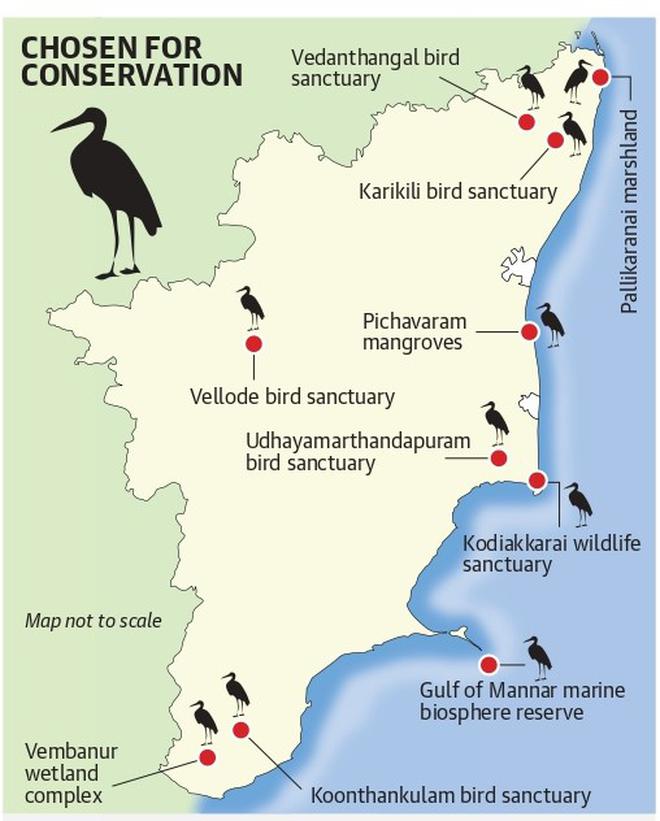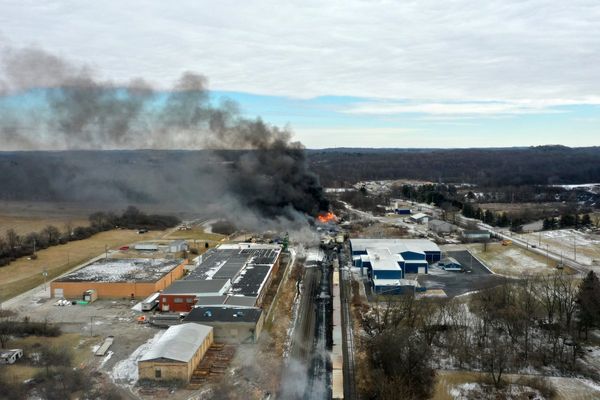In just one week, Tamil Nadu’s count of Ramsar sites, wetlands of international importance, went from just one to 10. It was 20 years ago, in August, that the Point Calimere Wildlife and Bird Sanctuary was declared a Ramsar site in the State. For the next two decades, it remained the only such designated site. Something has changed. For starters, the State seems to have improved its credibility with its commitment to environment issues, at a time when the country has set its sights on the Ramsar tag for 75 sites on the occasion of the 75th anniversary of Indian independence.
Naturalists and wildlife enthusiasts, not to forget birders and forest officials, were in for delight this past week, when after two decades, first three, and then six more wetlands in the State got the Ramsar site recognition. “Congratulations, Tamil Nadu. We just added six more to our list of four, reaching 1st position in India alongside UP with a total of 10 Ramsar sites,” Supriya Sahu, Secretary, Environment, Climate Change and Forests Department, wrote on Twitter after the official announcement came.

What comes with the Ramsar tag though? No doubt, there is prestige and also funding, but great responsibility, too. The tag will help to promote and tap into ecotourism potential responsibly and enhance international visibility. The Centre and the State, in particular, must ensure the wetlands are protected and conserved. Constant monitoring is necessary and any slackness could earn the wetlands negative points and delisting if the degradation is not stopped, activists say.
Miracle in metropolis
The Pallikaranai marshland in the heart of Chennai, an ever-expanding metropolis, poses a huge challenge to conservation. While there is no doubt that the marsh deserves international importance; it remains a haven for birds, both resident and migratory, though it has shrunk to one-fourth of its original size. The most important feature is that its protection is critical to flood management in south Chennai, says Jayshree Vencatesan, founder, Care Earth. Since it is in the middle of a metropolitan city, there is no buffer to the marsh and the edge conditions are very sharp and so the pressure is high on the wetland, she points out.
The Perungudi dump continues to be the biggest challenge, followed by the road network. The encroachments on the Velachery-Tambaram route, with more houses coming up encroaching upon the marsh, are the other threats, she says. Another development on the southern side is the ELCOT complex, which has blocked the flow from more than 30 lakes that drain floodwater into the marsh. There have been some minor adjustments, and there are plans to correct this, according to forest officials.
“It is a miracle that despite all the pressure that includes domestic and treated sewage, the birds continue to flock the marsh. 2018-19 was the best season as there was continuous rain, like this year, and not downpours for a few days,” says KVRK Thirunaranan of Nature Trust. He has been birding at the marsh for over a decade and the patterns of migration amaze him. There are concerns though: the south side is losing floating vegetation that was the nesting ground for nearly 800 pheasant-tailed jacanas. This year, the sandpipers have already flown down. Birds like the bronze-winged jacana that were not seen in 2014 are coming in. “The diversity is good and the migration happens on the exact dates,” he says.
“The Pallikaranai marsh has already been saved. As funding is not a problem, it is time for consolidation,” Ms. Jayshree says. Mr. Thirunaranan feels the approach has to be holistic and everyone has a role to play. He commends the print media for its role in saving the marsh over the past two decades.
At Pichavaram, the verdant mangrove region is a unique ecosystem spread over 1,000 hectares. It straddles the Vellar and the Coleroon that flow into the Bay of Bengal and acts as a bio-shield. K. Raman, founder of Indigenous Biodiversity Foundation, says the ecosystem has been facing threats over the years, owing to climate change, sea level rise and anthropogenic pressures such as pollution and proliferation of shrimp farms that have been drawing water illegally from the natural creeks in the mangrove ecosystem.
According to M. Anbarashan, researcher with the French Institute of Pondicherry, an experimental study in the mangrove forests revealed that the salinity in mangroves, which usually ranges from 0.6% to 36.2%, had increased by more than 5% owing to an average temperature rise of 3.1 degrees Celsius and an annual rainfall decline of 4%. “Many trees of rhizophora species are either dead or are dying because of high salinity, inadequate rain and fresh water inflow, pollution and climate change. The diversity and density of planktons, fungi, benthic forms have decreased by 10% and this population dynamic change can influence the biomass of the other marine animals like fish, crabs, birds by bottom-up effects,” he says.
“The freshwater flow from the Coleroon into the mangroves has also come down drastically over the years. The government must ensure the degraded mangroves are also rehabilitated to protect this unique ecosystem,” says A. Gopalakrishnan, assistant professor of marine sciences, Annamalai University.
Wilderness unlimited
Spread over 38,500 hectares, the Kodiakarai (Point Calimere) Wetland Complex, the first Ramsar site in Tamil Nadu, is home to the largest population of the endemic Blackbuck in southern India. About 364 species of flowering plants, including 198 species of medicinal plants, have been recorded.
S. Balachandran, Deputy Director of Bombay Natural History Society (BNHS), said safeguarding mudflats was of paramount importance for enriching bio-diversity. The BNHS has advocated a plan for rejuvenation of Point Calimere and full restoration of its environment for winged friends. During December 2021, the Forest Department approached Chemplast and the Department of Industry to hand over parts of the unsurveyed salt-pans and the swamp areas, measuring about 28,000 hectares, to be added to the sanctuary. This initiative would pave the way for making the wetland the best habitat for flamingos and waders, adding significance in no small measure to its categorisation as the Ramsar site, he notes.
Marine diversity
Endowed with three distinct coastal ecosystems of coral reef, seagrass bed and mangroves, the Gulf of Mannar Biosphere Reserve is considered one of the world’s richest regions from a marine biodiversity perspective. The Gulf’s 4,223 species of plants and animals make it one of the richest coastal regions in India. The sea bottom of the inshore area around the islands are carpeted with seagrass beds which serve as an ideal feeding ground for dugong, the endangered herbivorous marine mammal. The State is planning the country’s first Dugong Conservation Reserve.
The primary threats are habitat destruction, over-harvesting of marine resources and land-based marine pollution, according to forest officials. Though coral mining has been stopped since 2005, habitat destruction continues to be a serious threat. Seagrass beds are damaged by inappropriate bottom trawling practices and pollution. The development on the southern side could also have an impact in the longer run, the officials say.
Community efforts
Vedanthangal is a classic example of the local community caring for and nurturing a bird sanctuary. The first in the country, it has retained its magical charm over a century in a verdant landscape. Recently, there was a controversy over reducing its core habitat, leading to protests, despite the previous government clarifying that it was demarcating eco-sensitive zones, a claim that no one believed. The present government has announced that there would not be any change in its boundaries. Still the local activists say the flow into the sanctuary is blocked and diverted, and therefore the birds leave for the nearby Melmaruvathur lake at the beginning of the season. They want the proposal pending with the government to be implemented and this annually recurrent issue to be resolved at the earliest to ensure the migratory season starts on time. “Karikili with its twin lakes in the shape of half-dumbbells is even more silent,” says a forest official.
The Department does not permit any industry to come up within the buffer zone and continuously educates local residents on the need to maintain the sanctuaries, he says. Local residents, however, rue that the business outside Vedanthangal is seasonal during the migratory season and they need help to get year-round income. They have urged the State government to take steps to involve them in the conservation of both sanctuaries so that they get income all through the year. Karikili also needs better infrastructure for tourists.
Koonthankulam, about 25 km from Tirunelveli, is another site where the local community has protected the wetland for five decades. “Those who tried to poach birds a few decades ago were paraded on donkeys after their heads were tonsured. It was the punishment slapped on them by Koonthankulam villagers,” recalls a retired revenue official. Even now, the villagers do not burst crackers during Deepavali to ensure that the birds live and breed peacefully. Only after witnessing the villagers’ determination did the Forest Department declare it a bird sanctuary in 1994 and the official conservation efforts have yielded excellent results, with over 224 species of birds recorded so far.
“To take conservation to the next level, the Forest Department should launch conservation measures in the tanks in nearby Vijayanarayanam, Kazhuvoor and Ramakrishnapuram too. Then, this sanctuary will be one of the biggest in the country,” says M. Mathivanan, coordinator of ATREE’s Agasthyamalai Community Conservation Centre.
“Moreover, the villagers should be encouraged with incentives for growing Prosopis on their land as the painted storks nest on these trees in large numbers. The farmers of these villages may be encouraged to follow organic farming and shun chemical fertilizers and pesticides,” he suggests.
Nondescript sites
One of the nondescript Ramsar sites among the 10 is the Udhayamarthandapuram bird sanctuary in Tiruvarur district. During the migratory season, over 50,000 birds come to this sanctuary spread over 45 acres, located 10 km from the coast. “Over the years, we have been carrying out small maintenance work and the local tourists do flock,” says K. Arivoli, District Forest Officer, Tiruvarur. He also expects the Ramsar tag for the Vaduvoor bird sanctuary, spread over 316 acres, in Mannargudi taluk soon.
At the Vellode bird sanctuary in Erode, the major challenge is the availability of a permanent source of water for the tank in the sanctuary that is home to resident and migratory birds. “Currently, rainwater and seepage of the Lower Bhavani Project canal is the only source that ensures water availability for only six months a year,” says District Forest Officer S. Gowtham. In the past four years, rainwater ensured storage in the tank for two years, while the tank dried up because of poor rainfall for two years. Hence, creating a permanent source of water will make the sanctuary an ideal habitat for the birds, he said.
The Vembanur wetland complex in Kanniyakumari district is another relatively unknown bird sanctuary. The sustained efforts at protecting it from encroachment and industrialisation have resulted in the Ramsar certification, says District Forest Officer M. Ilaiyaraja. “With this recognition, we will take this spot to the next level through sustained conservation strategies.”
“On the whole, these waterbodies should be kept free of two weeds: Eichhornia crassipes and Ipomoea cornea. The nallahs that bring in water should be kept free of encroachment. No garbage should be dumped in the waterbody and no polluted water should be allowed to flow into it. Introduction of exotic fish, such as the African catfish, should never be allowed,” says A.J.T. Johnsingh, a renowned wildlife biologist.
(With inputs from S. Prasad in Puducherry, Deepa H. Ramakrishnan in Chennai, R. Krishnamoorthy in Tiruchi, P. Sudhakar in Tirunelveli and S.P. Saravanan in Erode.)







